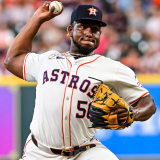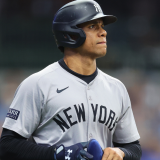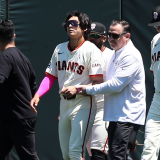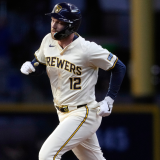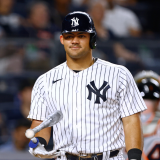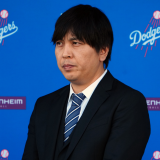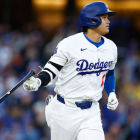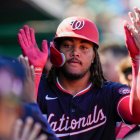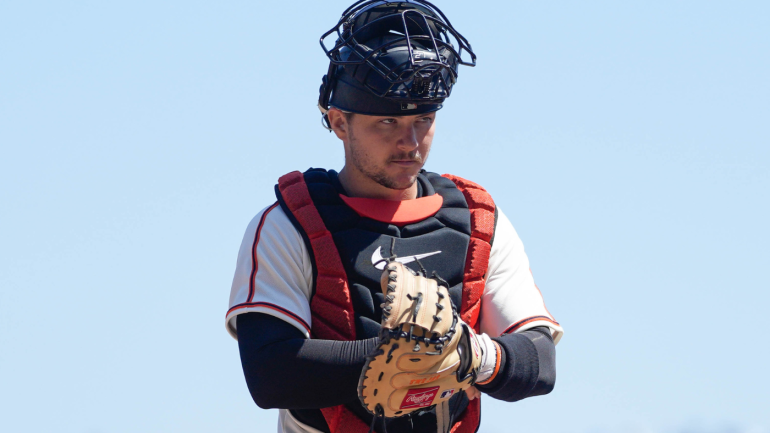
Believe it or not, Major League Baseball's regular season is about to enter its final month. That makes this as good of a time as any to devote some space to various players having underappreciated seasons. As such, this edition of Prospect Watch will highlight one player per division who we've otherwise neglected to cover this season for whatever reason.
Do note that we've avoided using any "young player" description as a means of giving ourselves options. The players included in these pieces don't have to be rookies and they didn't have to be top prospects. Our only guidelines were that they were "unestablished" as of spring training, and that they had less than one full season of big-league service time as of Opening Day.
Let's get to it.
AL East: Luke Raley, OF, Rays
Raley, closing in on his 29th birthday, entered the season with as many career trades as big-league home runs (three each). He's emerged as an important part of Tampa Bay's most-days lineup, homering 18 times and posting a 134 OPS+ through his first 100 games.
The theme of Raley's season has been taking advantage of opportunities -- and that applies in more ways than one.
How did this ball not get out?!
— MLB (@MLB) August 16, 2023
This might be the coolest inside-the-park home run you’ll ever see. pic.twitter.com/ZlJf27VbrD
Raley has been deployed in a strict platoon role by manager Kevin Cash. More than 90% of his plate appearances have come against right-handed pitchers. Brandon Belt and Zack McKinstry are the only non-switch-hitters with a similar amount of playing time and a higher share of the platoon advantage.
Raley's game features an extreme amount of swing and miss, with him ranking in the first percentile in contact rate. He doesn't exactly command the zone, putting all the onus on his ability to hit the ball hard. Luckily for him, he's been able to answer the call in that respect. It's not a stretch to write that most of his damage has come on pitches located in the heart of the zone. Take a look:
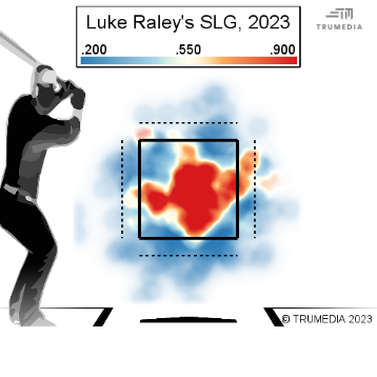
There's nothing wrong with that, really; most home runs are pitched, not hit. Nevertheless, we do have reservations about Raley's long-term outlook. Sustaining this kind of production from a limited skill set is tough work. Maybe he proves to be the exception -- he has so far this year -- but we suspect the Rays will cash in on his great year (and avoid the downside) this winter.
AL Central: Cole Ragans, LHP, Royals
It's not often we can write about the Royals pitching staff in a positive light. Ragans, acquired from the Rangers earlier this summer as part of the Aroldis Chapman trade, has given us the opportunity after six great starts with K.C.
Ragans had made 17 appearances, all in relief, with the Rangers prior to the trade. He had amassed a 5.92 ERA and a 1.71 strikeout-to-walk ratio. The Royals plopped him down in their rotation in mid-July, and after six outings he's sporting a 2.08 ERA and a 4.70 strikeout-to-walk ratio. Go figure, huh?
Cole Ragans, 100mph on his 99th Pitch. 💯
— Rob Friedman (@PitchingNinja) August 23, 2023
11th K. pic.twitter.com/Rlwbe9XHg1
Ragans made several tweaks following the trade, including a few mechanical alterations (he resumed working from the windup instead of the stretch and he lowered his average release point by about an inch). From an arsenal perspective, he introduced a slider that has generated 45% whiffs and 53% chases. Oh, and he's throwing harder than he did with the Rangers: his 90th percentile fastball has clocked in at 98.6 mph versus 97.4 mph.
We'll have to wait and see how the league adjusts to the new-look Ragans. Left-handed starters with this kind of velocity, swing-and-miss breaking ball, and control are hard to find. Even if he doesn't keep up this pace, you have to give the Royals credit: they made a pretty good trade.
AL West: José Caballero, INF, Mariners
The Mariners acquired Caballero from the Diamondbacks at the 2019 deadline in exchange for right-hander Mike Leake. Remember that one? (Us neither.) He emerged from the minor-league mist earlier this spring, and now he's closing in on a three-win season, according to Baseball Reference.
It's tempting to describe Caballero as the platonic ideal of a throwback player. He runs fast (he's stolen 25 bases on 28 tries); he's a good defender at second (he's recorded five Outs Above Average, per Statcast); and power is very much not a part of his game (he has a .100 ISO and an 82 mph average exit velocity). Yet we don't think it's an accurate description because of his batted-ball spray.
Immediately after committing a fielding error that allowed Maikel Garcia to reach, José Caballero delivers an 85.5 mph seed on a relay to throw him out at home plate and preserve the Mariners' 2-1 lead here in the 6th inning. pic.twitter.com/PhsFoclUAc
— Daniel Kramer (@DKramer_) August 17, 2023
When you think about the kind of player described above, you think about them hitting bushels of ground balls and low-flying line drives while generally keeping the ball out of the air. You think about Tony Kemp (average launch angle: 9.4 degrees) or maybe Adam Frazier (14.5). You don't think about that kind of player having an average launch angle of 23 degrees. You wouldn't want to -- it violates the profile on aesthetic and spiritual grounds.
Nonetheless, Caballero's average launch angle is the seventh highest among all hitters with triple-digit plate appearances. Everyone ahead of him has at least four ticks of average exit velocity on him. How does Caballero do it despite almost never barreling the ball or hitting it deep? By leading the majors in pop-up rate. Seriously, 18% of his batted balls have been classified as pop-ups -- that's the highest mark among any batter with at least 100 trips to the plate.
Caballero has those aforementioned secondary skills, and he's been a pest versus left-handed pitching. (He's hit .312/.459/.403 with the platoon advantage, thanks in part to getting plunked eight of 16 times in 98 trips to the plate.) We would be lying if we thought that his profile -- with all its weak contact and automatic fly outs -- was going to stand the test of time. Baseball would be more fun if it did though.
NL East: Cristopher Sánchez, LHP, Phillies
The Phillies obtained Sánchez from the Rays in November 2019 for infield prospect Curtis Mead. Prior to this year, that deal didn't look like it was going to age very well for the Phillies, with Mead emerging as a high-quality prospect and Sánchez struggling in his big-league cameos while mostly pitching in relief. Sometimes you just have to have a little patience and faith.
Cristopher Sánchez, Dirty Changeups. 👌👌 pic.twitter.com/M4WFCiiTb3
— Rob Friedman (@PitchingNinja) August 26, 2023
Sure enough, the read on that swap looks different now that Sánchez has emerged in the Phillies' rotation. He doesn't miss a ton of bats, but his three-pitch mix plays up thanks to a deceptive delivery that sees him get well down the mound and throw across his body. Sánchez has become particularly skilled at locating his low-90s sinker, while his low-80s changeup serves as both his top bat-missing and ant-killing weapon. On a related note, his 58% grounder rate is one of the highest in the majors among starting pitchers.
We suspect that Sánchez won't crack the Phillies' playoff rotation -- at least not if everyone else is healthy -- but we're curious to see if and how Rob Thomson deploys him during the postseason.
NL Central: Will Benson, OF, Reds
The Reds have an impressive collection of young position players on their big-league roster. Even so, Benson has arguably been their most productive hitter this season. He's batted .278/.379/.502 (134 OPS+) with eight home runs and 14 stolen bases in 78 games. Not too shabby for someone the Reds obtained in a minor trade with the Guardians prior to the start of spring training.
Benson has been deployed in a platoon role for the most part, seeing righties more than 85% of the time. He's an imposing figure, listed at 6-foot-5 and 230 pounds, and he's always been touted for his approach and his strength. His maximum exit velocity ranks only in the 35th percentile, however, and his slugging has been carried by his 11 doubles and six triples, the latter of which has allowed him to show off that he moves well despite his size.
First MLB career grand slam for @_thekidbilly_‼️ pic.twitter.com/7bJ8cDWKgP
— Cincinnati Reds (@Reds) August 26, 2023
Benson has struck out in more than 30% of his trips to the plate. That's probably not going to change too much. He combines a very patient approach with a tendency to swing and miss more often than the league-average. His strikeout tendencies were likely one of the main reasons the Guardians felt comfortable punting without giving him an extended big-league look.
As such, we're curious to see how Benson's career unfolds. There's certainly some good stuff here, but he'll have to continue walking a fine line with his strikeout rate to make it work.
NL West: Patrick Bailey, C, Giants
Bailey, the 13th pick in the 2020 draft, has solidified himself as the Giants' catcher of the present and future in a hurry. Over his first 74 games at the big-league level, he's batted .256/.307/.396 (93 OPS+) with six home runs and 39 RBI. Those marks have been accompanied by below-average walk and strikeout rates, as well as subpar exit-velocity readings.
Truthfully, it almost doesn't matter how much Bailey does or doesn't hit; we're confident he's going to have a lengthy career thanks to his defense.
Bailey ranks in the 100th percentile in framing, per Statcast. Baseball Prospect estimates that his throwing alone has been worth three runs -- that sounds meager, but just one other big-league catcher's throwing has been worth as many as two runs. Catchers are responsible for only so much of the running game, but he's nailed 33% of attempted thieves and has likely dissuade countless others from trying because of absurdity like this:
How impressive was Patrick Bailey’s game-winning pickoff?
— KNBR (@KNBR) August 2, 2023
According to @SlangsOnSports, it was the fastest pop time (1.39 sec) to 1B on a successful pickoff throw in the Statcast era 🤯
🎥 @NBCSGiants pic.twitter.com/jE7qBGcAeI
Don't be surprised if Bailey ends up being the breakout star for the Giants if they find a way to make it into October.







